Erika Mailman's Blog, page 19
July 3, 2012
Three week class...and fun link
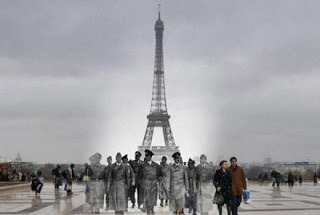 And just so this post isn't completely self-serving, here's a link I recently discovered that I just LOVE. Make sure not to visit until you've got a good mug of coffee with you because you will probably be glued to your seat for hours cruising through the archives. It's a wonderful look at the past (my favorite place!), and with a tagline I find irresistible: "the past is a foreign country. This is your passport." I give you: Retronaut.
And just so this post isn't completely self-serving, here's a link I recently discovered that I just LOVE. Make sure not to visit until you've got a good mug of coffee with you because you will probably be glued to your seat for hours cruising through the archives. It's a wonderful look at the past (my favorite place!), and with a tagline I find irresistible: "the past is a foreign country. This is your passport." I give you: Retronaut. June 29, 2012
Governor's mansion in Sacramento
Governor George Pardee (1903-07) was the first to use this as a gubernatorial residence; it was initially built for another family. Of course, we were interested in this house given our interest in George! He brought his wife and four girls in from Oakland and installed them in the three-story mansion.
Over the years, time has taken a toll on the building despite its still-stellar exterior. You can only visit the first two floors, although the third is due to open soon from water-damage reconstruction. We toured the building with the belief it was to close on July 1; our tour guide reassured us that the museum had been given a temporary stay of execution, operating with reduced hours. Yay!

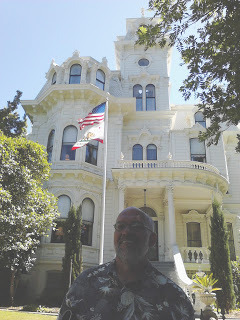

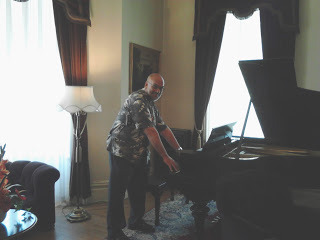 The coach house, too, is fantastic viewed from the outside. Note the horse head over the entrance, still original. Inside is a nice gift shop. This coach house is larger than many homes. Must've been nice for the horses.
The coach house, too, is fantastic viewed from the outside. Note the horse head over the entrance, still original. Inside is a nice gift shop. This coach house is larger than many homes. Must've been nice for the horses.. . . . .
May 25, 2012
ONLINE summer literary festival
April 13, 2012
Sneak peek at Pixar campus

All my life, I've loved being around creative people. Last week, thanks to a freelance assignment, I gained access to the closed campus of Pixar Studios in Emeryville, California.
This was incredibly exciting to me. I love the playfulness and true drama of Pixar films, so yes, it was worth it to me to travel four hours round trip (and squeeze in a visit with a few old wonderful friends too) to be on campus for a few hours and watch a thirty-minute teaser clip of the new movie Brave.
Driving through the monumental front gates (and seeing each car ahead of me really get grilled; there is no such thing as being waved through here), I felt the thrill of being in a place where everybody is thinking story.

I parked (even that was exciting) and waited in line to enter the main building. In this photo, you can see that it contains an atrium with lots of light. That room was filled with hanging banners for Brave (set in old-world Scotland) and almost has a Hogwarts kind of feel. Backing up a bit, in the photo you can see the tiered seating of an outdoor amphitheater. For this visit it held a Stonehenge-like circle of stones, and across the meadow, a bunch of archery targets. Having not yet seen the film, I thought these were, respectively, permanent art and a recreation opportunity for staffers.
Waiting in line to enter the main building, the woman ahead of me chanted to her friends, "We're at Pixar! We're at Pixar!" I felt the same way but curbed myself, since I was alone and you never look healthy when chanting to yourself. Immediately inside, you're greeted by giant replicas of Scully, Woody, Buzz and other buddies from the oeuvre. There's also a glass case of trophies including six Oscars and a million other glinty pieces.
Security to enter the theater itself was much stricter than the airport. All cell phones had to be turned in to a sort of coat check for electronics, and when they look through your purse, it's not a cursory glance. They are moving things around and really looking. I had not thought of my Garmin nuvi ("Jack") as a person of interest, but I had to go back and add him to coat check too!
The director and producer made wonderful introductory remarks, the movie clip was delicious, and we were all escorted to another building for a lavish refreshments spread. This was held in an open-air patio reminiscent of the Standard Hotel's rooftop in L.A. A great view of the campus could be had from here: I saw one guy swimming lonely laps in the pool, and there is a volleyball court, basketball court, gym, and cafeteria: basically, Pixar is a village and no one need go home until their creativity lapses.
Thanks, Pixar, for the opportunity to visit this incredible facility. (Now, would you like to hire me?)
March 19, 2012
National Keep Your Chin Up Day for Writers

I originally wrote this post as an email to a Facebook acquaintance, who was clearly getting depressed about his inability to find a traditional publisher for his novel, but as it lengthened I thought it'd be worth posting here. I remember those dark days myself very clearly, and my heart goes out to anyone in this situation--because getting a novel published isn't just something that would be cool for us; it's something that validates how we see ourselves.
I remember that if I met someone new and identified myself as a writer, they'd invariably ask, "So have you published anything?" and then you have to embark on the Road to Apologia, why this is, and how hard you've tried, and you came close with that one agent, and you attended that conference and had a nice talk with that publisher, and how you keep trying and you…
Yes, it sucks.
So I'm appointing today National Keep Your Chin Up Day for Writers. I have a few thoughts to share that hopefully will serve as a bit of a pep talk.
1. Nearly every published writer I know (myself included) had about six novels under the bed when they finally got that offer. Count up your own manuscripts: two? Three? You may need to keep churning them out, because with each novel your craft improves. Writing is mysterious, and I do believe in innate talent, but as with everything single thing in this life, we get better with practice. So keep practicing.
It occurs to me that this bit of cheer may backfire, that a writer may say, "I can't keep doing this to myself! I just finished my third book, and that's IT. You're telling me I have to write three more?!" Someone who really cares about their career will nod philosophically and take the long view that it's worth it to keep working, keep improving, and finally get a publication contract for a book that's your best effort.
And after all, you can't force a book to sell. You can revise based on editorial feedback, you can try again; you can try multiple times! But at some point, you have to cut your losses and start the next project. Soon, the joy of creating a new world within your novel will ease your feelings of feeling frantic about the previous book. And with what you learned from the new novel, you may wish to launch another revision on the old. But at least you'll have another fresher, better book to try to publish.
2. Joining a writers group really helps with the emotions of being unpublished. Kvetching together, sharing the anticipations as queries go out, consoling each other when rejections happen, cheering each other on to try again: that's something that non-writers can't really offer. They don't "get" what's so important about being published.
I heartily recommend finding a real-person writers group, but online works too. For those in the San Francisco Bay Area, I have just the group for you. It's led by Tamim Ansary, it meets for free every Tuesday night, and there's incredible camaraderie and support. Tamim's an incredible mentor and generous critiquer (generous in terms of the thoughtfulness involved in his responses, not that he necessarily praises) and your writing will improve if you listen to him.
The other thing about joining a writers group is that suddenly the idea of being a writer becomes more real. It's one thing to type away in your home, but when you're sharing your work with other writers, equally serious about their craft as you, your idea of yourself as an author gains more weight, validity. It will seem more possible that you can do this successfully.
3. Keep reading books you love. It's not escapism, it's not a reason not to write. It's research--because every single sentence you imbibe resides in you. The more you read, the more those different ways of constructing a sentence moil around in your head. You give your brain more options. You are tutoring yourself subconsciously.
4. "It only takes one person to say yes." I'm sure you've heard that do zens of times, but it's so true in the publishing industry. It doesn't matter that 50 agents sent you form rejections, if one says, "I love it!" Your onus is to find the person most likely to say yes. Like I said in #3, keep reading…and when you find a book that's similar to yours in tone or aesthetic, look at the Acknowledgments section to see if the author thanked their agent. That's a good person to target.
zens of times, but it's so true in the publishing industry. It doesn't matter that 50 agents sent you form rejections, if one says, "I love it!" Your onus is to find the person most likely to say yes. Like I said in #3, keep reading…and when you find a book that's similar to yours in tone or aesthetic, look at the Acknowledgments section to see if the author thanked their agent. That's a good person to target.
Another good tactic is to subscribe to Publishers Marketplace (you can do it for $20 for one month, jam through the archives, and cancel, if money is an issue): you can see what's selling right now to editors, and which agents are doing that selling. See an agent's name several times, linked with books that are similar to yours? That's another good person to target.
You can also look through those thick tomes of agent directories (or better yet, www.agentquery.com), but that doesn't give you a feel for what the agent likes. Just knowing they represent historical fiction, for instance, doesn't necessarily mean that they like books set in Colonial America. Look at the agent's website and rifle through their client list. Can you get a sense of the agent's personality through the books he/she has chosen to represent?
Keep your chin up. There's a part of this process you can control, and you should: the rest of it is out of your hands. The best thing you can do is move to the next project, and let the current novel marinate. Mark your calendar for six months from now, and re-read it.
Is that chin in the air yet? Higher! Like Cora in Downton Abbey, let me see that plastic surgery scar! I offer you an e-hug and a rueful e-smile, because I've been there. Believe me, I've really, really been there… and I hope the Gods of Publishing will soon smile on you and your novel.
. . . . .
February 25, 2012
Getting down at Downton
This is a post on Downton Abbey, because I'm in love with the screenwriting…and frankly I can't stop thinking about the show.
Last year, someone told me I would love Downton Abbey, and that she'd watched each episode of Season 1 four times. Four times! I thought that was quite a ringing endorsement, but I still dragged my feet because I don't watch much TV.
Then another friend recommended it again this year. I was inspired one evening to look for it on Netflix, but spelling it Dounton or whatever I was doing (Dontown?) yielded no results so I gave up.
A while passed before I tried again…and honestly, I'm so happy. Being a "late adopter" meant that I could watch all of Season 1, and then dive instantly in Season 2. I'm going to start watching Season 1 again--I don't know if I'll manage four viewings like my friend, but most definitely I want to go back "knowing what I know" and watch how things unfold.
Julian Fellowes is an incredible storyteller. I loved Gosford Park (and was influenced by it in my current novel-in-progress), and Downton Abbey is more of the same delectable upstairs/downstairs drama. So many of the things I find fascinating about the past are included in the show: the sinking of the Titanic, the 1918 flu.
And more recently I learned that the Crawley family is in part based on the Carnarvon family. SWOON. EXCITEMENT. The very name Carnarvon elicits a Pavlovian response in me: that sense of awe as I imagine that solitary candleflame flickering for the first time in centuries on pharaonic gold.
Lord Carnarvon was financier to Howard Carter, discoverer of King Tutankhamen's tomb in 1922. I've been obsessed with this discovery since I was a child. I remember on my wall I had taped up a kids funny pages article about it. My very first signed book was David Macauley's Pyramid, and he signed it to me, "Greetings from the tomb." I love ancient Egypt.
Howard Carter's story is so compelling. He was told the Valley of the Kings was "exhausted," and everyone considered him a fool for continuing to dig. He kept spending Lord Canarvon's money, and this was to be his very last season as Carnarvon was withdrawing support. And then a staircase appeared in sand…and they dug…and they dug…and Howard Carter looked through a chink in the wall to the Treasury.
He was asked if he could see anything, and famously answered, "Yes, wonderful things."
Ah, so pithy! How I love you, Howard Carter.
So, now knowing that Downton Abbey may show us a beautifully-filmed version of this moment…oh it's making my heart race. There's so much good stuff here: commoner Howard Carter's gossiped-of romance with Carnarvon's daughter Evelyn (a close match with the name Edith?) which had to be quashed, Carter's illicit smuggling out of the country many antiquities, and… well, no plot spoilers but two words: mummy's curse. I do hope we get to see this!
But even if we don't, I know whatever Fellowes cooks up for us will be devoured with great gusto. (And don't even get me started with the news that his next series will be about the Titanic. I was such a Titanicophile--that doesn't look right--that watching James Cameron's movie, I instantly noted that he had hired actors who looked like photographs of the actual crew members. The Titanic story is deep in my blood for some reason, and I was disappointed Downton Abbey only glossed over it. How extraordinary will it be when Fellowes actually focuses on it!)
I was marveling the other day that somehow with this gigantic cast of characters (looking at the most recent cast picture, I count 18, and that doesn't include dear Bates or lost Lavinia) we understand each person's story and care deeply about them. What a feat, to balance such a volume of stories.
My favorite character? Mrs. Patmore. Lesley Nicol is an incredible actress, with an expressive face. She so perfectly expresses the staunch demeanor of someone who knows her place, but can wiggle a little to assert herself. I will never forget her lost expression as she sat on the bed by herself, Anna having left her, to await her dreaded eye surgery.
There are a few things to quibble with. For instance, Matthew's constant popping in from war ("The trenches? Oh, yes, I'll go back in just a moment. But in the meantime, I'm terribly interested in my own love story, and I'll surely avoid shellshock by holding onto this stuffed puppy"). For another, the lack of resonating emotion for very big events, like Lady Crawley's miscarriage (of the very vaunted male heir!), or the in-house death of a diplomat. We go so quickly from thing to thing, and it'd be great to slow down just a little and digest these momentous plot twists.
But they are just quibbles. Downton Abbey is the best fun I've had with TV in quite a long time, and like I said at the top of this post, I'm thinking about it all the time. I can't believe we have to wait (sob sob) until next January to see Season 3. I may just have to move to England to see it earlier.
. . . . . .
January 6, 2012
Storybook architecture
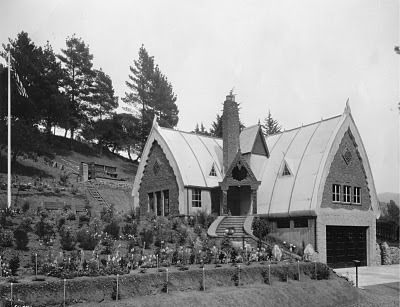
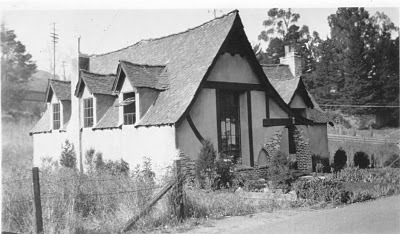
A reader emailed me recently. She had remembered my (long ago! dating to 2002) Montclarion column about Storybook architecture in Oakland. This style is near and dear to my heart. The article is not cached online, so I'm going to post it here on the blog, slightly rewritten from its original text.
Storybook is the style of architecture that makes you feel like you suddenly slipped into the Germanic forest of Hansel and Gretel, and are peeping at a quaint cottage in the clearing. The Montclair neighborhood boasts two wonderful public examples, pictured here.
At top is the firehouse on Moraga Road. Its roof is not supposed to be painted white to represent snow, but should rather shine with its original copper finish to represent flames –see them roaring up at either end of the building-- quite appropriate for a firehouse. Note the scalloped roofline, the heart above the entry, the tiny windows in the eaves: all illustrative of that olde worlde charm.
The other structure is the library on Mountain Boulevard. Its roofline was built to look like it was already sagging for centuries, although the library was quite new at the time of this photograph. You can see the clinker brickwork behind the bushes and its general homespun, European appeal.
I must credit the coffeetable book Storybook Style: American's Whimsical Homes of the '20s by local architect Arrol Gellner. It's filled with gorgeous photos by Douglas Keister of many Bay Area buildings, including private residences in Oakland, Berkeley, Piedmont and Alameda. In an email interview, Gellner told me that he thinks "Storybook Style homes, more than any other, represent the embodiment of the builder's personality, creativity and sense of humor. They're also a snapshot of an optimistic era when anything seemed possible, which no doubt appeals to people in these jaded times."
So what defines Storybook? Gellner calls it a "rambunctious evocation of medieval Europe" and sets the three criteria: an overstated rendition of medieval forms, use of artificial measures to make the building look extremely old, and the third, amorphous quality: "whimsy."
Storybook homes, at their most extreme, have crooked chimneys, lopsided walls, roofs that undulate like the wind making waves on a pond, misaligned shingles, askew shutters, clinker brick: all things to suggest antiquity, as if the very house is settling due to its age. Some homes have drawbridges (like Humphrey Bogart's Hollywood home) or streams with bucolic bridges over them, reminiscent of a pastoral Europe.
Gellner presents an interesting reason for why Storybook architecture arose. Even dating to the 1700s, people were fascinated by the Middle Ages (my dictionary says the Middle Ages ended in 1500, so the fascination began 200 years later). For instance, Marie Antoinette's famous "farm" at Versailles was her interpretation of a medieval countryside hamlet. The 1869 castle Neuschwanstein (which Disney later based his Sleeping Beauty castle on) is in essence fake, because it purports to look far older than it is.
Gellner points out that because Victorian style was so fussy, with its overwrought gingerbread detailings and interior doilies and tassles, people longed for a return to simpler times, like the society of a medieval town where goods were made by hand rather than in a factory. This was the basis of the Arts and Crafts movement, which valued craftsmanship. By the 1920s, people were ready for Storybook architecture, which allowed them to pretend they had stepped back in time. However, it seems to me that storybook architecture is a little fussy on its own, with turrets and eaves and different roof levels. Gellner says Storybook architecture relies on Craftsman ideals (like using natural materials, buildings of a small scale and architecture that appears organic to its setting) that were "recast in a rather more theatrical style."
And why theatrical? A major factor contributing to the rise of Storybook was the indomitable presence of Hollywood. By the 1920s, talking movies had created the first "stars" – people whose homes needed to reflect their unique standing in life. Moreover, there was a ready workforce that was used to creating fantasy sets – or was inspired by them – builders whose dials were already set on creative. Hollywood is indeed, as Gellner says, the "epicenter of Storybook style," although I did see at least 10 Oakland buildings featured in the book, as well as a handful from other Bay Area cities.
Another reason for this style? Men returning from WWI with memories of appealing European villages.
Sometimes entire housing tracts were built in Storybook style. Three are local, and were all based on designs by Oakland-based architect W. W. Dixon. One is Stonehenge in Alameda, another is Normandy Gardens in Oakland, and the third is on Oakland's Ross Street. This street was chosen because its electrical and phone cables had already been undergrounded by the time of the construction, and the street had pleasant light standards, rolled curbs and concrete pavement rather than asphalt. Part of the Ross Street tract, built by R.C. Hillen, was removed during freeway construction in the 1960s.
A few other streets host Storybook enclaves. One is 75th Avenue near MacArthur Boulevard. This stretch is called Holy Row, Gellner says, because at one point many of the homes were lived in by various church leaders. These homes were built in the early 1930s. Another street is the charming, tiny Veteran Way in the Dimond District, with three full-fledged Storybook homes and several "almosts."
Storybook architecture was gone by the late 1930s when Art Deco took over—a style that was also revivalist, looking in part to Egyptian motifs after the 1922 discovery of King Tutankhamen's tomb. Unfortunately, there are few buildings left. Gellner told me "Sometimes we (he and photographer Keister) had to spend days just to find one good one. It was like finding a diamond buried in a sand dune." So Oakland should certainly appreciate its good fortune in having many structures!
. . . .
December 16, 2011
Timberline's True Name

--This is a reposting; I know there is renewed interest in Woman of Ill Fame and so I'm going to put this blog post up again.
This blog is currently about witchcraft persecutions, ancient and modern, but now and then I will dip into material regarding my first novel Woman of Ill Fame. The novel is about a Gold Rush prostitute in a dangerous, brand-new San Francisco.
A few days ago, someone was in my archives and saw my post about the real-life prostitute whose image is featured on the cover. All I knew was that her name was Timberline, she was a Dodge City prostitute, and her image is in the collections of the Kansas State Historical Society.
Well, the anonymous commenter wrote that her name was Rose Vastine.
That for one thing totally threw me. Although I fashioned my character based on this photograph and named her Nora, for some reason I had "felt" that this real woman's name was Kate.
Secondly, the commenter wrote that she earned the name Timberline for being 6'2" in height. Another big surprise. In my mind, the nickname had dirty connotations!
Armed with her real name, I consulted Professor Google.
The first link I accessed made me gasp out loud in the café I was working in, and literally grab my forehead. According to Linda Wommack's Ladies of the Tenderloin, "Timberline climbed up into the hills above Creede and shot herself not once, but six times."
When you have spent so much time staring at someone's photograph and constructing an entire novel around them, you develop a strange and intense connection to them. It was almost as upsetting as hearing this news about someone I knew…but not only was Timberline a stranger to me, but she died 150 years ago. Whatever sorrows she endured, they are dust now.
I dedicated the novel to two wonderful women the world lost at an early age, and on the second line dedicated it to "Timberline and the other girls of the line: I hope the world was kind to you."
And here was evidence that the world had not been kind to her.
The link went on to say that Timberline did not die from that suicide attempt, but strangely enough, another link had her recovering from an "intended overdose." Is it apocryphal that she tried to kill herself with such vastly different methods and survived both times? Whatever the truth is, she must have been an unhappy young woman.
Several sources have her living in Creede, Colorado, a silver mining camp 420 miles from the Dodge City that her photograph is labeled with. Sure enough, the website for Creede, Colorado mentions Timberline on its "About Creede" page. Bat Masterson too (whose biography the commenter mentions) lived in both cities, so maybe she hitched a ride with him.
If anyone has any more information on her, I'd most definitely love to know it.
. . . . .
December 14, 2011
Germanic wood sculpture

Sculptor Stefanie Rocknak makes the incredible life-sized pieces you see here, inspired by the medieval art of Germany.
I was so taken with these images (seen in my alumni magazine, Colby: we both attended the same college) that I contacted Rocknak to rave. There's so much emotion captured in these faces and in their body language. I feel like I could stare at them for hours to try to figure out what their individual stories are.
There's something about these figures that is timeless and we see they are the same as us today...but deep in the wood is the darkness of their shortened, brutal lives. They lived in a world where superstition reigned, where food was scarce, and where they couldn't even use logs to warm their huts (only nobles could burn logs; peasants were reduced to whatever branches they could scrounge on the ground).
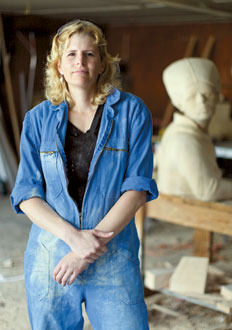
These sculptures visually show what I tried to convey with words in The Witch's Trinity. In fact, had I known of Rocknak's work in 2006, I would have begged and pleaded with my editor to have one of her pieces on the cover --or maybe even this triptych, which to me looks like the priest, Gude and Irmeltrud.
Check out Rocknak's artist statement on her website. I love her eclectic, whimsical look back at what fueled her work (like her brother's wooden robot, or a face she carved with her dad as a child), rather than some high-flung attempt to interpret her philosophy for others.
This image of her is from the Colby magazine article by Pat Sims. I love how the statue in the background is arching around to look at the camera too.
October 21, 2011
Nice review of Witch's Trinity
I met her at the Historical Novels Society conference this year in San Diego. I had a great time sitting with her at dinner and talking shop. One cool thing about her (among many) is that she is required to drink about five cups of coffee a day. I thought it was great to have a medical dictate to freely imbibe! She was a lot of fun, and now she has written a really nice review of my book, on top of buying multiple copies of my book. Many thanks, Susan!
. . . .



